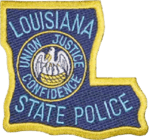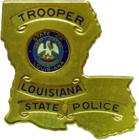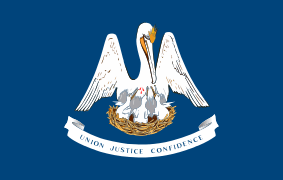Louisiana State Police
| Louisiana State Police | |
|---|---|
| Abbreviation | LSP |
|
Patch of the Louisiana State Police | |
|
Badge of the Louisiana State Police | |
|
Flag of the State of Louisiana | |
| Motto | "Courtesy, Loyalty, Service!" |
| Agency overview | |
| Formed | 1922 |
| Preceding agency | Louisiana Highway Commission |
| Employees | 1,548 (as of 2004)[1] |
| Legal personality | Governmental: Government agency |
| Jurisdictional structure | |
| Operations jurisdiction* | State of Louisiana, US |
 | |
| LSP Troop Map | |
| Size | 51,885 square miles (134,380 km2) |
| Population | 4,468,976 |
| Legal jurisdiction | Louisiana |
| General nature | |
| Operational structure | |
| Headquarters | Baton Rouge, Louisiana |
| Troopers |
1,063 (as of 2004)[1] 1,215 (as of 2008)[2] |
| Civilians | 485 (as of 2004)[1] |
| Agency executive | Colonel Mike Edmonson, Superintendent |
| Parent agency | Louisiana Department of Public Safety & Corrections |
| Facilities | |
| Troops | 9 Troops |
| Website | |
| http://www.lsp.org | |
| Footnotes | |
| * Divisional agency: Division of the country, over which the agency has usual operational jurisdiction. | |
The Louisiana State Police is the state police department of Louisiana, which has jurisdiction anywhere in the state, headquartered in Baton Rouge.[3] It was created to protect the lives, property and constitutional rights of people in Louisiana. It falls under the authority of the Louisiana Department of Public Safety & Corrections. It is officially known in that organization as the Office of State Police. The badge worn by its troopers is very distinctive in that it is shaped like the state of Louisiana. The Louisiana State Police is a premier law enforcement agency in Louisiana and was accredited by the Commission on Accreditation for Law Enforcement Agencies (CALEA) from 2003 to 2008.[4] The agency voluntarily ceased its association with CALEA in 2008.
In popular culture
- The LSP is featured in the 1973 film, Live and Let Die.
- The first season of HBO's True Detective depicted Matthew McConaughey and Woody Harrelson as Louisiana State Police detectives.
History

The organization began in 1922 as the Louisiana Highway Commission with 16 Highway Inspectors covering approximately 2,700 miles (4,300 km) of roadway. These inspectors patrolled exclusively by motorcycles. These motorcycles were personally owned by the individual patrolmen, and maintained by an allowance from the state.[5] Of the 16 men on the force, one was a captain. This captain served as superintendent of the force. The highway commission was divided into ten districts. The Baton Rouge District had two patrol officers, while the New Orleans District had three patrolmen. The other eight districts had one patrol officer each. The other two officers patrolled statewide on the main highways of the state. In 1928 the agency was known as the Law Enforcement Division of the Highway Commission, and employed 70 uniformed officers. The Bureau of Criminal Investigation was also formed about that time. In 1932, the organization's name was changed to the State Highway Patrol, and it was given the authority to carry firearms. The agency was used by Governor Huey Long as his personal bodyguards, who escorted him all over the state. In 1936, the two divisions of law enforcement were combined, by an act of the Louisiana Legislature, to form the Louisiana Department of State Police. The department's force of patrolmen numbered over 40 at that time, and the primary patrol vehicle was the motorcycle. In 1939, the State Police was divided into eight "troops". Troopers in cars and motorcycles were patrolling nearly 2 million miles per year throughout the state. The agency's fleet of patrol motorcycles eventually grew to 64 motorcycles. In 1942 the Louisiana Legislature abolished the Department of State Police and made it a division of the newly created Department of Public Safety. The state police accepted new responsibilities in 1946, when the state's Drivers License Law was enacted requiring every driver to hold a license for operating a motor vehicle. Prior to this time, only the operators of commercial vehicles, trucks, and buses were required to be licensed in Louisiana. In 1948, the number of motorcycles operated by the agency had fallen to 36 motorcycles. The department was relying more heavily on automobiles for patrol purposes, and eventually patrol motorcycles were only found in New Orleans and other major cities. Motorcycle patrol units were used throughout the 1950s, with Governor Earl Kemp Long also using them as bodyguards. In the 1960s, the department was utilizing motorcycles, automobiles, airplanes, and helicopters for enforcement purposes. The department had exclusively used Harley-Davidson motorcycles until the 1980s when it switched to Kawasaki motorcycles. A short time after this switch, the motorcycle patrol program was disbanded. In 1997, patrol motorcycles were brought back on the force. The agency continued to make advancements with the current number of troopers employed by the department listed as 1,022.[6]
Patrol areas
The department is divided into nine troops, with its headquarters in Baton Rouge. The troops are divided as follows:
- Troop A (Baton Rouge): covers the following 9 parishes: Ascension, East Baton Rouge, East Feliciana, Iberville, Livingston, St. James (east bank), Pointe Coupee, West Baton Rouge, West Feliciana
- Troop B (Kenner): covers 6 parishes: Orleans, St. Charles, St. John (east bank), Plaquemines, St. Bernard, Jefferson
- Troop C (Houma): covers the 5 parishes of Assumption, Lafourche, Terrebonne, and the west banks of St. James and St. John
- Troop D (Lake Charles): covers the 5 parishes of Allen, Beauregard, Calcasieu, Cameron and Jefferson Davis
- Troop E (Alexandria): covers the parishes of Avoyelles, Catahoula, Concordia, Grant, LaSalle, Natchitoches, Rapides, Sabine, Vernon and Winn
- Troop F (Monroe): covers the Parishes of Union, West Carroll, East Carroll, Morehouse, Lincoln, Ouachita, Richland, Madison, Jackson, Caldwell, Tensas, and Franklin.
- Troop G (Bossier City): covers the Parishes of Caddo, Bossier, De Soto, Webster, Claiborne, Bienville, and Red River.
- Troop I (Lafayette): covers Parishes of Evangeline, St. Landry, Acadia, Lafayette, St. Martin, Vermilion, Iberia, and St. Mary.
- Troop L (Covington): covers the parishes of St.Helena, St. Tammany, Tangipahoa and Washington
Disbanded troops
The following troops are no longer in existence:
- Troop H (Leesville) comprised Vernon, as the home base parish, and Sabine and Beauregard Parishes. It was disbanded in 1988 due to budget considerations.
- Troop K (Opelousas) included Avoyelles, Evangeline, Pointe Coupee, and St. Landry Parishes. It was disbanded in 1988 due to budget considerations.
- Troop M (Des Allemands) closed in 1973 when merged into the current Troop C. It comprised Lafourche, Terrebonne, Assumption, the West banks of St. Charles, St. John, and St. James Parishes.[7]
- Troop N (Crowley) included Acadia and Vermilion parishes. Disbanded in 1969.
- Although never officially classified as a Troop, Troop N was reopened in New Orleans, in 2005, as headquarters for post-Hurricane Katrina operations until April 2006. It was again reopened in April, 2015, to oversee deployments of temporary extra troopers to the New Orleans French Quarter detail.
- Troop O (Delhi) comprised Franklin, Richland, Tensas, Madison, East and West Carroll Parishes. Troop O was created in 1968. It operated from the city hall building in Delhi, Louisiana. It was very short lived, lasting a mere 13 months before being disbanded in 1969.
Rank structure
| Rank | Insignia | Description |
|---|---|---|
| Colonel | One individual is appointed (by the Governor) as the Deputy Secretary of the Department of Public Safety and Superintendent of the State Police and holds the rank of Colonel. The Colonel wears one silver colored eagle on each epaulet.[8] | |
| Lieutenant Colonel | There are four officers with the rank of Lieutenant Colonel, each overseeing one of the four bureaus within the State Police. Lieutenant Colonels wear a silver colored oak leaf on each epaulet. | |
| Major | Majors are responsible for a command within the State Police. Majors wear one gold colored oak leaf on each epaulet. | |
| Captain | The specific responsibilities of a Captain vary depending upon where they are assigned within the Agency. For example, a Captain may be a Troop Commander in the Patrol Bureau or a Division Commander in one of the other Bureaus. Captains wear two gold colored bars on each epaulet. | |
| Lieutenant | The responsibilities of a lieutenant vary within the department. At the Troop level, a lieutenant is typically the commander of a shift. Other Lieutenants in other divisions may command a unit. Lieutenants wear gold colored metal bars on each epaulet. | |
| Sergeant | Sergeants act as assistant shift commanders or duty officers. Sergeants wear three yellow inverted chevrons on each sleeve under the State Police patch. | |
| Master Trooper | The insignia for this rank consists of a gold colored 'MT' collar pin worn on the wearer's right lapel. Troopers who complete fifteen (15) years of satisfactory or exceptional service are promoted to the rank of Master Trooper. | |
| Senior Trooper | The insignia for this rank consists of a gold colored 'ST' collar pin worn on the wearer's right lapel. Troopers who complete ten (10) years of satisfactory or exceptional service are promoted to the rank of Senior Trooper. | |
| Trooper First Class | The insignia for this rank consists of a gold colored 'TFC' collar pin worn on the wearer's right lapel. Troopers who complete five (5) years of satisfactory or exceptional service are promoted to the rank of Trooper First Class. | |
| Trooper | The insignia for this rank consists of a gold colored 'TPR' collar pin worn on the wearer's right lapel. This rank is attained by Cadets upon successful completion of the training academy. | |
| Cadet | A Cadet is a raw recruit, and is the rank held by all personnel while assigned as a student at the training academy. These personnel do not wear rank insignia. |
Weapons
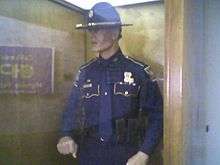
The current standard issue firearm for LSP Troopers is the Glock 22 in caliber .40 S&W. Previously, the standard issue sidearm was the SIG Sauer P220 semi-automatic pistol in caliber .45 ACP. Other optional handguns are also authorized for carry on-duty. Each trooper is also issued a Remington 870 Police 12 gauge shotgun. Some police cars are also equipped with a Colt AR-15 A2 in .223, a Ruger Mini-14 in .223, or an H&K MP5 in 9mm. The troopers in this agency have been issued batons and pepper spray for quite some time. Tasers have also been introduced, and have been in service since 2005.
Patrol cars
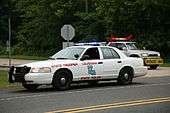
The current primary Louisiana State Police patrol vehicle is the Chevrolet Tahoe. The agency began a conversion to the Tahoe in 2012. Previously, the agency used the Ford Crown Victoria "Police Interceptor." This vehicle was the main patrol vehicle used by the agency since 1997, when it replaced the Chevrolet Caprice. The vehicle's markings include "State Trooper" written on each front quarter panel, a state badge on the center of each front door, the words "Louisiana State Police" written above and below the door badge, and the words "State Police" written on the trunk. Note that the markings on the Tahoe include a slight variation to the previously used designs. In 2012 the coloring on the door badge has been redesigned. It changed from a light blue to a darker blue, with a state seal done differently as well. It is completely different from the prior one used since 1964 except in dimension. The red "LSP" lettering also now has a small dark blue border around each letter. An "ACE" insignia, consisting of a blue State of Louisiana with a red lighting bolt, is awarded to troopers who recover five or more stolen vehicles within a year. Since approximately 2001, a majority of the marked patrol vehicles utilized by this agency have been equipped with onboard video cameras. Other 'marked' patrol vehicles currently used include Harley-Davidson motorcycles, the Chevrolet Impala, the Chevrolet Camaro, the Chevrolet Suburban, Chevrolet Caprice, Ford Taurus, and the Dodge Durango. Several other unmarked vehicles in various makes and models are also used for various non-patrol purposes. Police vehicles currently being tested and considered for use include the Dodge Charger. In August 2010, nearly all marked Chevrolet Impala vehicles in inventory were taken out of service, with only a few still in service.
Special units
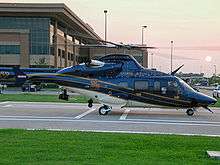
Like many other state police agencies around the United States, the Louisiana State Police has several sub-divisions specializing in addressing particular crimes or security needs. These include a Bomb Squad, an Air Support Unit, a Special Weapons And Tactics (SWAT) Team, an Executive Protection detail (for the Louisiana Governor, Lt. Governor, and other dignitaries), a Motor Carrier Safety Enforcement (MCSAP) section, and a Hazardous Materials Response Unit.
The Criminal Investigations Division includes a Statewide Narcotics Task Force, a Concealed Handgun Permit Section, an Auto Theft Recovery Unit, the Casino Gaming & Licensing Section, a Criminal Intelligence Unit, Identity Theft Investigations, an Insurance Fraud Investigations Section, and a cyber crimes section which specializes in online and computer crimes.
The agency also operates the State Police Crime Laboratory.
The agency previously ran a section called the Anti-Terrorist Assistance Program (ATAP) which was a joint venture with the U.S. State Department. This ATAP section trained foreign police and military forces in detecting, preventing, and fighting of terrorism.
Fallen officers
Since its formation in 1922, 27 LSP troopers have been killed in the line of duty. The most common cause of line of duty deaths to date is Automobile Crashes.[9]
- Neill A. Yarborough, Sr. Jan. 25, 1925
- Geronimo C. Trevino Aug. 8, 1932
- Frank David, Sr. Oct. 9, 1933
- Victor A. Mossy May 13, 1936
- John D. Williams Mar. 14, 1942
- Benton Finlay Apr. 19, 1942
- James T. Brownfield May 9, 1943
- Ulis Floyd Feb. 24, 1952
- Wilmer L. Moody Nov. 10, 1956
- James N. Pollard Nov. 20, 1956
- Eli L. Smith Jan. 17, 1957
- Francis C. Zinna Mar. 24, 1958
- Rudolph H. Miller Sep. 8, 1962
- Joseph D. Ferris Feb. 23, 1968
- Huey P. Grace Oct. 30, 1968
- Lamon Weaver Apr. 17, 1973
- William C. Warrington Jul. 19, 1973
- Clarence J. Miller Dec. 4, 1975
- Donald C. Cleveland Jul. 2, 1977
- Jean-Claude Crescionne Apr. 20, 1982
- Damon L. Robichaux Jul. 1, 1982
- William "Mike" Kees Feb. 5, 1983
- Stephen H. Gray May 29, 1995
- George "Doug" Johnston Nov. 17, 1997
- Hung N. Le June 30, 1998
- Duane Dalton Jan. 12, 2010
- John Kendall Aug. 9, 2011
- Stephen Vincent Aug. 24, 2015
See also
- Louisiana State Troopers Association
- Louisiana Department of Wildlife & Fisheries - Enforcement Division
- List of law enforcement agencies in Louisiana
- State police
- State patrol
- Highway patrol
- Mike Edmonson
- Francis Grevemberg
- Terry Landry
References
- 1 2 3 "Census of State and Local Law Enforcement Agencies, 2004" (PDF). U.S. Department of Justice. June 2007.
- ↑ "Census of State and Local Law Enforcement Agencies, 2008" (PDF). U.S. Department of Justice. July 2011.
- ↑ "Louisiana State Police Headquarters." Louisiana State Police. Retrieved on October 28, 2010. "7919 Independence Blvd. Baton Rouge, LA 70806."
- ↑ CALEA
- ↑ Edmundson, M. (2009, Fall). History of the Louisiana state police motorcycle patrol unit. The Motor Officer, 80(2), 18-19.
- ↑ LSP - About Us - Our History
- ↑ "Louisiana State Police". Lsp.org. 1936-07-28. Retrieved 2016-03-25.
- ↑ http://www.lsp.org/images/edmonson2.jpg
- ↑ Officer Down Memorial Page
